







IPCS |
International Programme on Chemical Safety |
 Safety
and Health in the Use of Agrochemicals
Safety
and Health in the Use of Agrochemicals
An ILO contribution to the
International Programme on Chemical Safety
(a collaborative programme of the United Nations Environment Programme the International
Labour Organisation and the World Health Organization)
Safety and health in the use of agrochemicals has been one of the primary concerns of international organisations and of many governments, employers and workers and their organisations for over two decades. Some agrochemicals such as pesticides are extremely hazardous to the health of workers and the general public, and also to the environment. However, they can be used safely if proper precautions are taken. Many industrially developed countries therefore enforce strict regulations with regard to the production, sale and use of pesticides, the most hazardous group among agrochemicals. These countries have banned or severely restricted the use of some very hazardous pesticides. It may happen that other countries may be compelled to import those banned or restricted agrochemicals because of specific needs, for example to eradicate a particular pest. For these countries the economic benefits of agricultural development outweigh the risks involved. Therefore, although the safety and health problems may vary in different countries, it is important to establish clear, common procedures for the use of agrochemicals.
All those who are responsible for the production, import, storage and sale of agrochemicals have a role to play in ensuring safety and health in their use. International organisations, governments, employers and workers and their organisations, and community leaders have a fundamental role: educating agrochemical users on the hazards of the substances they handle, how these enter the body, the nature of toxic effects and the proper methods of use, and informing them of the duties and responsibilities of government authorities, other organisations and the public.
2.1. How dangerous substances can enter the body
Most agrochemicals will have an adverse effect if they enter the body. Those that are more toxic are particularly dangerous even in small amounts. Many agricultural workers die and many more are poisoned or injured each year by such substances entering the body; the main routes of absorption are through the respiratory tract (inhalation), through the skin (dermal absorption) and through the digestive. tract (ingestion) - see figures 4-6. Almost all such casualties can be avoided by preventing the entry of agrochemicals into the body.
Figure 4. Inhalation
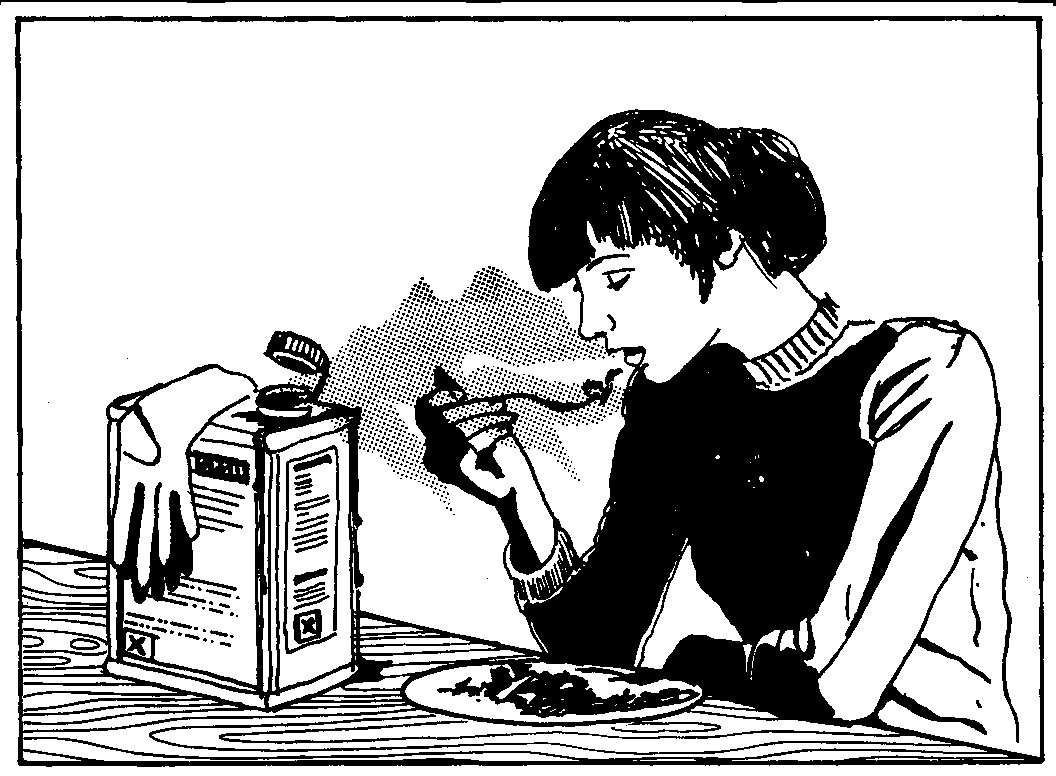
Figure 5. Skin absorption

2.1.1. Inhalation
Breathing agrochemicals into the lungs is more likely to happen if they are in the form of gases, fine spray droplets, dust, fumes and smoke. Gases mix with the air. Others tend to remain suspended in the air for some time after release, for example by spraying. Often these particles are so small or well dispersed that they cannot be seen. Spraying agrochemicals without adequate precautions is noted to be a common cause of poisoning by inhalation. Users of fumigants and gases are particularly at risk of poisoning by inhalation.
Figure 6. Ingestion

Animal handlers are at risk from inhaling the spray created by animals which shake themselves after emerging from veterinary treatment dips.
2.1.2. Skin absorption
This is one of the most common poisoning routes. Pesticides act on pests and destroy them by penetrating the insect's skin or surfaces of plants considered to be weeds. Therefore, these substances can easily penetrate the intact human skin, if allowed to do so. Some formulations are especially hazardous if they are both toxic and contain penetrative solvents such as kerosene, petroleum products or xylene. These may pass through work clothing unnoticed by the worker. Hot working conditions which open the pores on the skin add a further risk; they allow more rapid skin absorption, as does skin damaged by cuts, abrasions or skin disease. Further, many veterinary products are chemicals that can easily be absorbed through the skin.
Contamination of the lips and mouth or accidental swallowing of agrochemicals is often caused by poor hygiene or bad practice. Failure to wash properly before eating is a common cause, as is smoking during work. Attempting to clean a blocked sprayer nozzle by putting it between the lips and blowing through it is another bad practice.
In some countries pesticides and veterinary products are decanted from large and properly labeled containers into unlabelled bottles and sold. These could subsequently be mistaken for soft drinks and consumed. Such practices should be banned. Even very small quantities of a toxic substance could cause death if ingested in this way. Inhaled toxic substances could subsequently be ingested by swallowing contaminated sputum.
Many agrochemicals cause localised ill-effects on contact with skin or eyes even if they are not absorbed. They include some pesticides, strong acids such as sulphuric acid and strong alkalis such as caustic soda. Veterinary products may also cause problems when their use is subject to the added task of controlling the animal being treated. Accidental self-injection or needle grazing of the skin could.occur (figure 7). Such accidents may produce severe localised ill-effects, depending on the extent of skin penetration.
Figure 7. Injecting a piglet with iron to prevent anemia. (care should be taken when handling injection needles)

2.2. Classification and related measures
It has already been said that agricultural workers may be exposed to a variety of agrochemicals at work. Most of these are toxic. Therefore, all agrochemical users must know how to use the products safely by increasing their knowledge of the hazards involved, both to themselves and others. Knowledge is a powerful weapon which can be obtained by reading and understanding the label on the container. By strictly following the instructions on the label, agrochemical users will learn to protect themselves, other people, livestock, wildlife and the environment.
The hazards of the many thousands of agrochemicals on the market are described as toxic, harmful, corrosive, irritant, flammable, explosive or oxidising. This is called classification. Some agrochemicals may possess more than one of these hazards.
The word " toxic " has already been used in this guide to mean generally that a substance would cause ill-effects if it entered the body. In practice, the agrochemical container would It should be noted that words such as " toxic " or " harmful " have specific significance when they appear on a label. These words usually accompany a symbol.
| Note Agrochemical users must also remember- that the products they obtain for use are not highly concentrated. Usually the active in gredient in the agrochemical product is mixed with other substances; in some instances it may be dissolved in a solvent that might pen etrate the skin. The symbol to be used on the label is calculated, based on the percentage weight or volume of the active ingredient in the agrochemical product. Therefore, a prod uct with 10 per cent of the active ingredient might belong to a lower toxicity class than an other product with 25 per cent of the same active ingredient. It may be claimed by the manufacturers that the latter product is more potent, but users must remember that it is also more toxic. |
The toxicity of a substance is mainly determined from the results of laboratory tests on small animals such as rats. These tests determine the amount of the substance that kills up to 50 per cent of a sample of laboratory test animals within a specified period. The results and hence the toxicity of the substance are expressed in two ways, depending on the test procedure: whether the animals were made to ingest or inhale the substance.
For example, a lethal dose 50 (LD 50) of 25 means that when a diet containing 25 milligrams (mg) of the substance was fed to each animal among a group of rats, half of them died after a given period assuming that each rat weighed 1 kilogram (kg). In practice the amount of toxic substance to be fed is calculated according to the body weight of the test animal. Thus the animal feed would have contained only 12.5 mg of the substance if the rats weighed half a kilogram each.
Similarly, lethal inhaled concentration 50 (LC 50) refers to the amount of the substance that will kill 50 per cent of the test population by inhalation.
In practice, the agrochemical container would carry the hazard classification symbol rather than LD 50 or LC 50 values. However, it is important to understand the relationship between the two. It should be remembered that the lower the LD 50 or LC 60 value, the higher the toxicity.
As there are many varieties of agrochemicals, the labels are also different. Different symbols in several colours, as well as the words on the label, are used to describe the harmful effects. Therefore one should understand what the symbols and words mean.
A label might have the following symbol with one of the following words:
VERY TOXIC or TOXIC
This symbol with the words "very toxic " is used to label a substance which, if it is inhaled or ingested or if it penetrates the skin, may involve extremely serious, acute (immediate) or chronic (longer-term) health risks and even death. The same symbol with the word " toxic " also denotes a highly hazardous substance. The decision to use the word " toxic " is based on LD 50 values. Therefore, extreme caution is necessary in the use of these agrochemicals and instructions on the label must be strictly followed.
Very toxic and toxic substances might also be denoted on the label by hazard class, such as class 1a and I b respectively.
The following symbol with the word "harmful" should appear on the label of a substance which, if it is inhaled or ingested or if it penetrates the skin, may involve limited health risks. It might also be listed as an agrochemical in class II. It should be noted that class II presently denotes a," moderately hazardous" substance according to The WHO recommended classification of pesticides by hazard and guidelines to classification 1990-91.
The same symbol as for "harmful" but with the word " irritant " may instead be found on some labels. It is meant for a non-corrosive substance which, through immediate, prolonged or repeated contact with the skin or mucous membrane, can cause inflammation.
Other labels may specify that a substance belongs to toxicity class III, or class 4 or class 5, depending on the country classification concerned. There may be other labels with the words " does not belong to any toxicity class". Such classification is again linked to LD 50 values. It is important to follow instructions on the label in all cases.
The following symbol with the word corrosive " will be found on the label of a substance which may destroy living tissues on contact with them. Severe bums on the skin and flesh might result from splashes of such substances on the body.
| Note: While toxicity, irritancy and corrosivity describe health hazards, there are other symbols to denote important physical properties. Agrochemical users must understand these symbols and the words on the labels. This knowledge is necessary to avoid injury and accidents that may result in destruction of machinery, equipment and property. |
2.2.1.4. Flammability
The following symbol with the words "extremely flammable " denotes a liquid that would boil at body temperature and would catch fire if exposed to a flame. The same symbol with the words "highly flammable " denotes a substance which:
The same symbol with the word " flammable- " denotes a substance which is a liquid that would catch fire if it were allowed to warm above room temperature. Smoking or lighting a flame should be prohibited near flammable substances. Such substances should also not be exposed to direct sunlight or allowed to warm up.
The following symbol with the word "oxidising " denotes a substance which releases a lot of heat while it reacts with other substances, particularly flammable substances.
The following symbol with the word "explosive" denotes a substance which may explode under the effect of a flame or if subjected to shocks or friction.
2.2.2. Labeling and relabelling
The purpose of a label is to convey a message about what the product is, who makes it and how it may be used safely and effectively. Considerable effort goes into ensuring that labels communicate to the user in a clear, concise and easily understandable manner.
It follows that if the product is to be used safely, then users must first read, understand and comply with the label. This is as important an activity as any other involving the use of the agrochemical, and must not be neglected. If users experience any difficulty in progressing beyond this first crucial stage, they should seek advice before going any further.
Some agrochemical containers are too small for a label to be glued or stuck on. In such instances there should be a leaflet securely attached to, or tagged on to, the container. Users should always ensure that a leaflet is presented with small containers. Information might also include any literature provided separately in a package, e.g. product information documents or chemical safety data sheets. This material should not be overlooked by the user.
Labeled information seeks to identify a product and describes how, when and where it should be used. It is then completed with details of potential hazards, good practices, safety precautions, first-aid instructions and advice to health personnel.
Before using any agrochemical the user should read the label and discover the information. The following should be indicated:
Users should always read the label before use or, if they do not understand the instructions, ask someone who knows. If the label is too small and cannot be read, they should use a magnifying glass or ask someone with better eyesight to read it to them. If it is torn or defaced, it may be necessary to ask the supplier for another container on which the label is legible.
Agrochemicals may be transferred from labeled containers to other containers or equipment. This may be done by suppliers who import in bulk quantities or by the user at the farm. In all instances the person responsible for the transfer must ensure that other such containers are relabelled. Relabelling must ensure that the contents are identified in a manner which will make known to the users:
For further information reference could be made to FAO: Guidelines on good labeling practice for pesticides (Rome, 1985), and GIFAP (International Group of National Associations of Manufacturers of Agrochemical Products): F!pictograms for agrochemical labels, devised in cooperation with the FAO (Brussels, 1988).
2.2.3. Chemical safety data sheets
For each labeled agrochemical, suppliers should have a chemical safety data sheet. These should be supplied upon request to employers, agricultural officers and extension workers, and community leaders. Such data sheets contain essential detailed information regarding the identity and classification of the product, the hazards it presents and the appropriate safety precautions and emergency procedures.
As already mentioned, all agrochemicals should be labeled or marked (figure 8). The label should provide essential information regarding the identity, the classification, the hazards presented and the safety precautions to be observed. In addition it should cover the information on use described in section 2.2.2. Less hazardous agrochemicals, such as some fertilisers, should also be marked. Each marking should provide information on the identity and important properties relevant to the safety and health of users, as well as the name and address of the supplier.
Figure 8. All agrochemicals should be labeled or marked
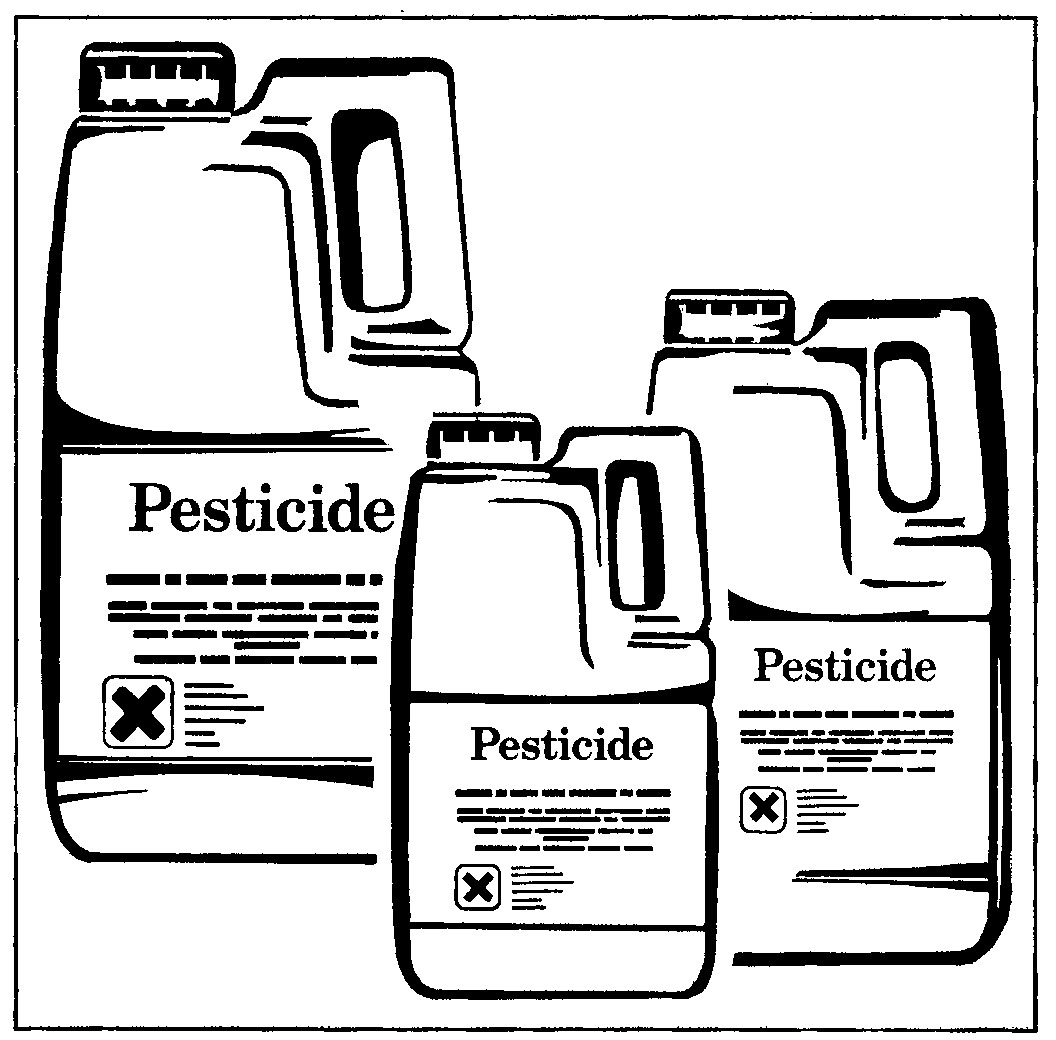
In addition to the essential information on the label, less hazardous agrochemicals might be accompanied by product information documents. Such documents would be indispensable in instances where chemical safety data sheets are not provided. This information is given to the user, at no extra cost, because it is important. Every user should read, understand and follow the instructions to ensure safety and health in the use of agrochemicals. Such information should include:
For agrochemicals that have been marked only to indicate their identity and are without a label, the supplier should provide on request, to employers and other users, information in order to determine any precautionary measures that need to be taken during transport, handling, use and disposal.
Agrochemical users should not attempt to use the product until they have read and understood the label or the marking. They should seek the advice of the employer, agricultural extension worker or community leader in case of doubt.
When an agrochemical product is unknown and the information for its safe use is not available, then it should not be used. If inquiries fail to discover its identity, it should be disposed of safely as described later in the guide (see section 2.3.9).
Discussion and activities (sections 2.1 and 2.2)
| Point to remember: If the label does not give information on hazards and precautionary measures, obtain the relevant information from the retailer, another user or a community leader before you use the agrochemicals. |
| Point to remember: Ask the retailer for a chemical safety data sheet. Bring it to someone who will explain the classification to you. This is particularly important if the label does not give the classification. |
Some agrochemicals such as fertilisers may not be classified, In these cases ask the retailer for any information or documentation on effective use that would give essential safety information.
This major section deals with packaging, transport, transfer, storage, dispensing, pesticide application, other agrochemical applications, spillage and disposal of containers and waste.
As pesticide application is a major activity in the use of agrochemicals and also the most hazardous, precautions to be taken before, during and after application are treated separately.
Storage, management of spills and disposal are also hazardous operations. Precautions to be taken, both for the safety of users as well as the general public and the environment, are described.
Reference is also made to a series of FAO guidelines that are relevant to this section. These include:
Agrochemicals are usually supplied in packages. These may vary greatly in size, from a small bottle or box to a large metal or plastic drum. Packages are made of glass, metal, plastic or paper. In some cases they are subject to high internal pressures. Liquefied gases such as methyl bromide or anhydrous ammonia could evaporate inside the container to exert pressures on its walls. Packages need to be resistant to these pressures or the corrosive action of chemicals.
Agrochemical users should know that each package must comply with the national standards and regulations that apply to the packaging of agrochemicals. Such regulations may not exist in some countries. Therefore, users should be aware of general requirements for packaging. This information will be useful to identify properly packaged agrochemicals during purchase. Improperly packaged products could cause health risks
An agrochemical package should be so designed and constructed that:
Figure 9. Opening a correctly designed container

Users should clearly understand that packaging and repackaging of agrochemicals is beyond their competence unless they have been trained to do so. Further, they should never attempt to repackage any agrochemical in a container not meant for it. Even if it had contained the same pesticide, there is a risk, for example, that the package may be damaged or the lid may not fasten properly. Users run a risk of contamination with toxic substances, by even trying to examine whether a container is fit for reuse.
Manufacturers, exporters and importers of agrochemicals should comply with international transportation and safety regulations. They might also have to comply with national regulations. Agrochemical users should be aware that such regulations exist. They are also concerned with transport, which may be from suppliers to farm or from store to field. Safe transport should ensure that:
Figure 10 shows pesticides being loaded on to a lorry.
Figure 10. Loading pesticides on to a lorry

Only in very exceptional cases should agrochemical products be transferred from one container to another. The practice has many disadvantages including the possibility that an agrochemical may mistakenly be consumed as a soft drink; this has caused fatalities in several countries. That is why the practice is banned in many countries.
Where in exceptional circumstances it is necessary to transfer agrochemicals from one container to another, the receiving container should be:
Precautionary measures should be observed when agrochemicals are transferred. Particular attention should be paid to protective clothing, removal of spillage, personal hygiene and the avoidance of contamination of any foodstuffs.
2.3.4. Storage
Agrochemicals are usually delivered to a store by the supplier or transported by the user. They are also returned to the store after partial use at the farm. During storage they are most vulnerable to theft, vandalism, accidental or deliberate misuse or the effects of extreme weather conditions. Users who have to store agrochemicals should know how to construct and maintain a place for storage, thereby ensuring their own safety and that of others. They should also take necessary action to prevent the pollution of the environment.
In general, safe and secure storage should ensure correct siting to allow easy access for the delivery of agrochemicals and transfer to farm vehicles. If the store is within a general-purpose building it should be separated from other stocks such as flammable materials. The location of the store should also take account of possible pollution risks from leaks and spillages. It should be situated away from living accommodation and surface waters such as rivers, streams and reservoirs used for the supply of drinking or irrigation water. Figure 11 shows an agrochemical store.
Figure 11. A correctly designed
agrochemical store

Stores should not be located:
There should be adequate capacity for storing the maximum amount of agrochemicals and provision for secure stacking and easy access.
Users should also ensure that any building used to store agrochemicals:
Figure 12. Avoid exposing
agrochemical containers
to direct sunlight
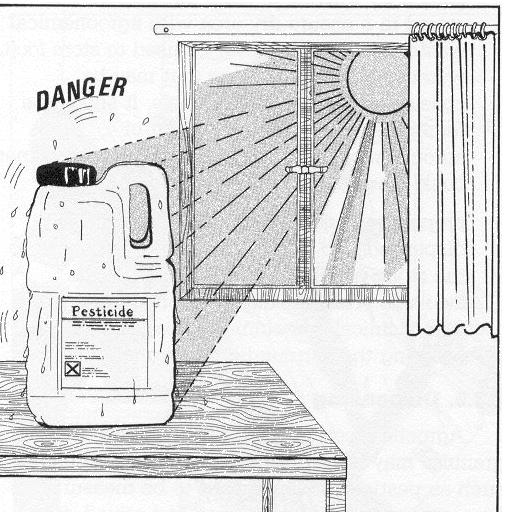
This could be avoided by shading windows or, if building a new store, by positioning windows. Electric lights and switches should be positioned so as to avoid mechanical damage and there should be an adequate separation distance between lamps and stored agrochemicals to avoid the transmission of heat;
is properly ventilated to remove stale or contaminated air. This may be achieved by the provision of " air bricks ". Where adequate natural ventilation cannot be provided, an extractor fan should be installed. In all circumstances the removal of air should be to a point on an external wall of the building of which the agrochemical store is a part;
is suitably marked with a warning sign (figure 13) and secured against theft. Any warning sign should conform to national requirements in respect of colour, pictorial symbol and geometrical shape. If national regulations have not been specified, the skull and crossbones is generally acceptable. The security of the store is important in preventing theft or misuse of contents by unauthorised people (figure 14). The extent of security should be adequate in all foreseeable circumstances;
Figure 13. Warning I Pesticide
storage I No access to
unauthorised persons!

Figure 14. Agrochemicals should be
stored under
lock and key
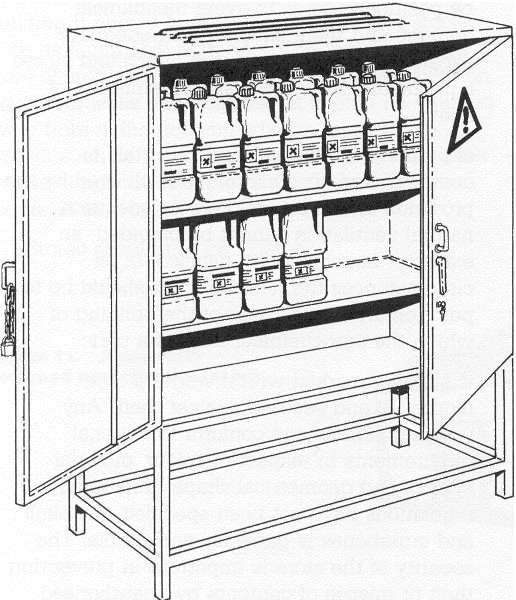
Other considerations:
Agrochemicals such as fertilisers, dusts and granules may be supplied ready for use. Others such as pesticides would need to be measured from concentrated formulations and mixed, for example with water. Dispensing agrochemicals in this way requires particular care to ensure that it is carried out safely and efficiently. This will include:
Figure 16. Set out the dispensing equipment in an uncluttered place
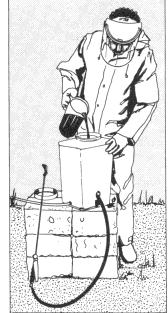
| Figure 15. Always read the label before using agrochemicals | Figure 17. Wear the appropriate protective clothing when dispensing agrochemicals |

2.3.6. Pesticide application
The safe use of pesticides is determined by the repairs care and attention given to precautionary measures before, during and after application. It is very important to select the safest agrochemical that will act effectively with the least risk to people, livestock, wildlife and the environment.
There are different types of application equipment. The type of equipment to be used depends on:
It is not possible to give safety instructions about the full range of agrochemical application machinery in this guide. Some general principles, particularly with regard to the use of portable sprayers, are listed under three separate steps: pre spraying, during application and post-spraying precautions. These must be observed in order to ensure effective and safe use.
Before discussing these steps, all agrochemical users must ensure that they are properly trained as sprayer operators. If a helper is at hand he or she should also be trained. Users should ensure that the training has adequately covered the following aspects of application:
Users should ensure that the users' instruction manual (or similar operating instructions guide) giving detailed instructions on:
is always available for reference.
2.3.6.1. Pre-spraying precautions
2.3.6.2. Precautions during application
Figure 18. Pour correctly from
large containers with
the spout uppermost

Figure 19. Lookout for overhead electricity cables

Figures 20 and 21 show correct methods of manual spraying.
| Figure 20. Correct method of using a knapsack sprayer | Figure 21. When spraying trees, take notice of wind speed and direction |
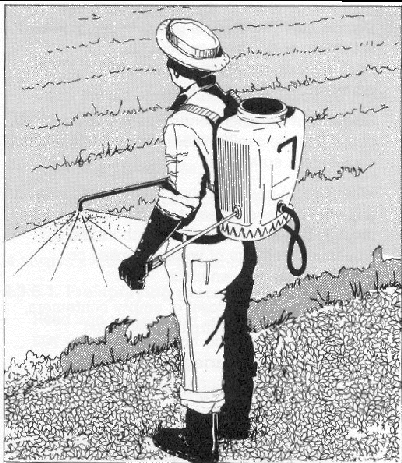
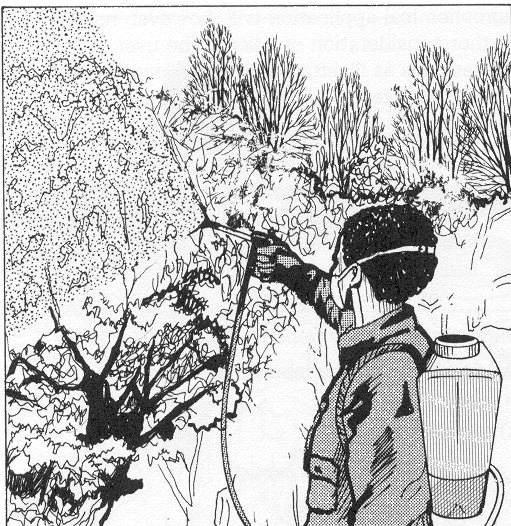
2.3.6.3. Post-spraying precautions
2.3.6.4. Re-entry
The time interval that should elapse between agrochemical application and entering the treated area for safety reasons is known as the re-entry period. It is an interval during which traces of the chemical would have been absorbed by the crop or otherwise removed from plant surfaces. In practice, the timing of the re-entry period is subject to many variables, such as the nature and toxicity of the product, its application rate, weather conditions and the surface area of the crop treated.
The minimum re-entry period should be increased substantially if entry into treated areas would result in exposure to more than an occasional skin contact or if individuals who might be susceptible had to enter. These may include children and others likely to develop skin allergies or similar adverse reactions on exposure to traces of chemicals.
If entry is required to a treated area before the re-entry period, then protective clothing appropriate to the pesticide should be worn.
The re-entry period should not be confused with the harvesting interval, which is the time between agrochemical application and the harvesting of a crop for eating.
Figure 22. Clean thoroughly all
equipment used for
application of agrochemicals. Take care not to
contaminate the environment with waste water
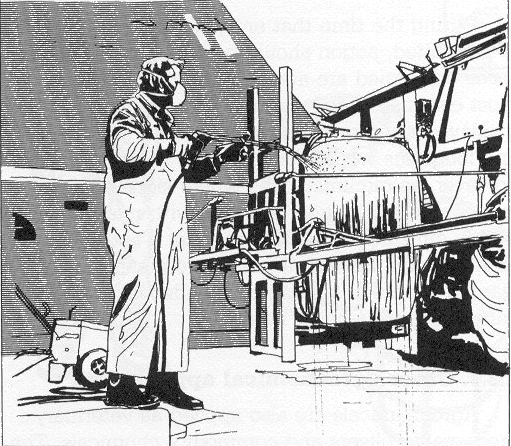
There may be circumstances when a re-entry period for animals is also prescribed. Animals may be particularly vulnerable to the agrochemical sprayed or to the effect of the agrochemical on the vegetation that might make it taste or smell different. This may confuse the animals into eating poisonous plants which they would otherwise avoid (for example, herbicide spraying on ragwort).
Minimum re-entry periods
The following re-entry periods could provide the necessary protection under normal conditions of use:
| Agrochemical | Suggested re-entry period |
| (a) Any agrochemical with a specific labeled or data-sheet requirement for re-entry | As described on the label or data sheet |
| (b) Any agrochemical which is classified as either very toxic or toxic and is applied as a spray, dust, granule or in any other form in the open air such as in a field, orchard, vineyard or hop garden | Three days |
| (c) Any agrochemical which is classified as harmful, irritant or corrosive but is applied as (b) above | Two days |
| (d) Any pesticide which is unclassified but to which the circumstances in (b), above, would otherwise apply | One day |
| (e) Any pesticide used as a fumigant or gas treatment within a building, greenhouse, mushroom shed or other enclosed space | 12 hours, but first ventilate for at least one hour or more to ensure a complete change of air |
During the time that entry to any treated area is prohibited, action should be taken to ensure that those concerned are aware of the restriction. In most cases a hazard warning sign prominently displayed at entry points such as field gateways and footpaths would be sufficient. There will, however, be circumstances where signs are inadequate. If children or adults with reading or seeing difficulties are likely to enter a sprayed area, an alternative but equally effective means of warning, such as fencing or a loudspeaker announcement, should be made.
2.3.7. Other agrochemical applications
Agrochemicals are also applied as veterinary products, fertilisers and commodity chemicals. The precautionary measures described earlier also apply to these types of product. Different methods of agrochemical application will, however, require further consideration of risks to the user.
Precautions as illustrated by the following examples should be taken:
| Figure 23. Avoid
contamination from animals shaking themselves after a pesticide dip |
Figure 24. Use
personal protective clothing when dipping animals |


Figure 25. Personal protective
clothing appropriate
for working with hydrofluoric acid

Agrochemical spillage is both wasteful and hazardous. It should be avoided wherever possible but when it occurs it should be dealt with immediately. Some common causes of spillage are:
Action in the event of spillage should include:
Figure 26. Using sand to contain
and remove an
agrochemical spill
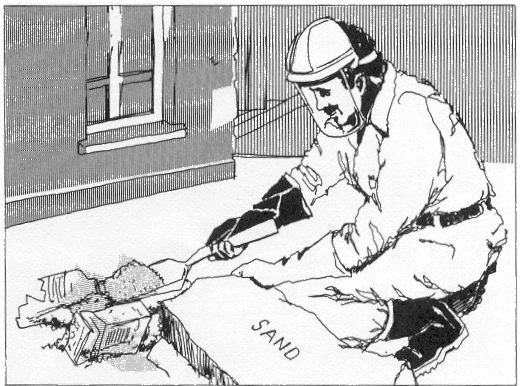
2.3.9. Disposal of containers and waste
There will be circumstances when agrochemicals in store need to be disposed of safely. They may no longer be required or may be out of date, or the packaging may be broken or the container damaged. Similarly, deposits of spillage clean-ups, discarded items grossly contaminated with agrochemicals, contaminated aqueous waste such as animal dips, and empty containers must be disposed of safely.
The following general steps should be observed during disposal of waste:
Agrochemical waste should never be dumped indiscriminately
Agrochemicals should never be disposed of so as to cause any risk to people, animals, crops, water supplies or the environment.
First of all, the supplier should be asked if he would accept the waste for disposal.
Whenever possible, waste should be disposed of through a company or persons licensed to handle waste disposal. Advice should be sought from the supplier, local authority or community leader.
Accumulation of waste should be avoided. Waste should be disposed of as soon as possible.
The user should read the label on the package or container for any specific advice on waste disposal.
Empty agrochemical containers should never be reused except possibly, if in good condition, to contain an identical product transferred from a deteriorated or leaking container. All other containers should always be cleaned thoroughly before disposal. They may be cleaned in accordance with the labeled instructions. In the absence of instructions, rinse the containers in water successively at least three times. Care should be taken to ensure that the water used for rinsing does not contaminate the environment; particularly drinking-water, for example.
Liquid containers should be drained out before cleaning. Ideally cleaning should take place when a spray mixture is being prepared so that the drained material and the rinsing liquid can be added to form a part of that mixture. In other instances the rinsings should be collected for subsequent disposal elsewhere. After cleaning, the containers should be punctured in several places or crushed to make them unusable, and stored in a secure compound until their disposal is arranged. Packages of dry powders and granules must be shaken out thoroughly into a mixing vessel or the applicator tank.
Containers may be buried on premises owned or occupied by the agrochemical user. The burial site must be chosen carefully so that there can be no risk of pollution to surface water or groundwater. The approval or the advice of the local authority should be sought beforehand. The containers should be buried to a depth of at least 1 metre below the surface and below the level of any land drains (figure 27). The area used should be fenced or marked with warning signs. A record should be kept of the dates and the material buried.
Figure 27. Containers and waste
should be buried at a depth of I metro
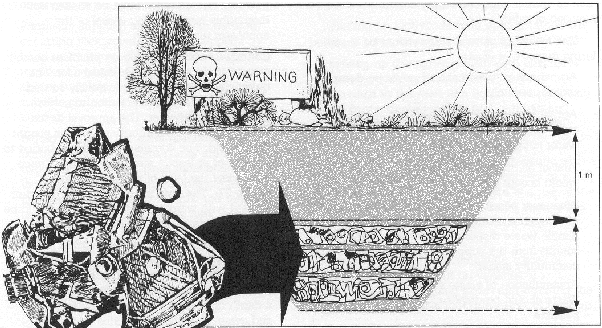
It should be possible to obtain the permission of the local authority to have a common disposal site, such as a landfill, for several users. It should allow secure burial of waste to a depth of at least I metre below the surface and away from any land drains or water courses so that there is no risk of seepage from the site which might cause pollution (figure 28).
Figure 28. Choose a safe disposal
site for burying agrochemical waste
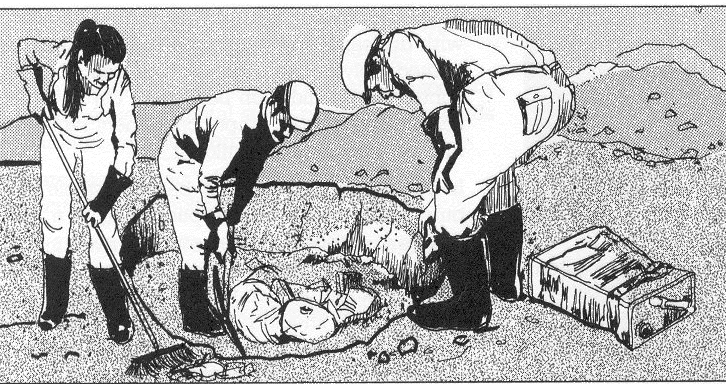
During burial of waste, protective clothing appropriate for the most hazardous product handled should be worn.
Containers in which hydrogen cyanide gassing powders or aluminium, magnesium or zinc phosphides were supplied, or which have contained these materials, should not be rinsed or cleaned with water when empty. These substances react with water to produce hazardous gases. Instead they should be filled with dry earth and punctured in several places immediately before disposal. The treated containers should then be buried. On no account should the empty containers be taken into or kept within a building.
In certain instances it may be permissible to burn lightly contaminated packaging as a means of disposal. Fumes and any smoke produced may, however, present a serious health risk and advice from the supplier of the agrochemical should be sought for any activity other than a very minor operation. The local authority should be consulted beforehand.
When waste packaging is to be burnt (figure 29), the user should ensure that:
(a) burning takes place in an open space at least 15 metres from a public highway and not in a location where any smoke produced is likely to drift over persons or livestock or move towards housing or business premises;
(b) a perforated metal drum or a fabricated incinerator is used for the bonfire;
(c) all containers are opened and placed on a very hot fire a few at a time;
(d) the fire is supervised constantly and care is taken to avoid breathing any smoke produced;
(e) the fire is extinguished after use; any residues resulting from the operation are buried as described earlier.
Figure 29. Burning agrochemical
containers

On no account should packaging or containers which have held any of the following pesticide formulations be burnt: benazolin, clopyralid, 2,4-D, 2,4-DB, dicamba, dichlorprop, fenoprop, MCPA, MCPB, mecoprop, oxadiazon, picloram,sodium chlorate, 2,4,5-T, 2,3,6-TBA, triclopyr; other pesticides or formulations classed as "highly flammable pyrotechnic devices ", e.g. smokes and atomisable fluid containers under pressure. These should be buried.
Some agrochemical operations may produce liquid waste. It will then be necessary for the user to provide arrangements for safe disposal such as the construction of a soak-away which should be environmentally acceptable for the types and quantities involved. The user should consult the local authority and seek the advice of the supplier.
On completion of spraying all the equipment involved in the operation needs to be cleaned, washed and rinsed. This will produce a relatively large volume of dilute pesticide for reuse or disposal. Possible disposal routes include authorised discharge into a sewer connected to a sewage works with or without some prior treatment, or the use of a suitable soak-away. The local authority should be consulted.
Discussion and activities
(section 2.3)
1. Packaging
1.1 List the different types of package used to hold agrochemicals in your store. What are their sizes and volumes?
1.2 Have you bought any damaged packages in the past at a reduced price? If yes, would you react differently now? How?
1.3 Give two good reasons why you would not buy damaged packages of agrochemicals
1.4 List five items you consider important to ensure that a package is up to the mark.
2. Transport
2.1 Who transports your agrochemicals?
2.2 When you transport your stock, by what means: cart, open truck, lorry?
2.3 Do you regularly or occasionally transport agrochemicals with other goods such as food items?
2.4 What precautions do you take to ensure that other such items are not contaminated?
2.5 Have you experienced any contamination by spillage or container damage during transport? If yes, how did it happen? How did you manage the situation?
2.6 How can you prevent such spillage or container damage from happening in the future? List five steps you would take to ensure safety and health in the transport of agrochemicals.
3. Transfer
3.1 Have you ever had a need to transfer agrochemicals from one container to another? If yes, what precautions did you take? Whom did you consult?
3.2 List four steps you would take to ensure safety and health in the transfer of agrochemicals; to another container.
4. Storage
4.1 How big is your store
4.2 How far is it from your dwelling
4.3 Where do you keep the register of your stock? How often do you take inventories?
4.4 How many persons, other than you, are authorised to enter your store? Did you ever experience unauthorised entry? If yes, what steps will you take to prevent a recurrence?
4.5 What special precautions do you take to ensure that children do not have access to the store ?
4.6 How do you ensure the security of your store so that no unauthorised persons have access to it?
4.7 Have you ever experienced any theft or pilferage? If yes, what additional security measures did you take?
4.8 What special arrangements have you made to facilitate storage after transport?
4.9 Have you informed the local authorities, fire authorities and agricultural inspector about the siting, quantities and products stored?
4.10 Did you ever experience a spillage or a fire involving agrochemicals; in storage? If yes, how did you manage? Did you make any mistakes that resulted in (a) self-contamination, (b) contamination of others, (c) 9. contamination of waterways or any other aspect of the environment?
4.11 List seven items that you consider important to ensure safety and health in the storage of agrochemicals.
5. Dispensing
5.1 Do you normally get a helper to assist you during dispensing chemicals? If yes, is he or she trained by you? How do you ensure that he or she takes the same precautions as you do?
5.2 List five steps that you would take to ensure safety during dispensing) agrochemicals.
6. Pesticide application
6.1 Who trained you in pesticide spraying? Do you have a licence? Is there a licensing procedure or certification of competence? Did you receive a certificate after your training? If not, why was it not possible?
6.2 List the types of equipment you use.
6.3 How often do you check that the equipment is in order?
6.4 For each of the following list steps that are required to ensure safety and health: (a) before application; (b) during application; (c) after application.
6.5 What is a re-entry period? Prepare a chart showing the re-entry periods you follow after application of pesticides you are using.
7. Other agrochemical applications
7.1 Do you rear animals? If yes, list the veterinary products you use. 7.2 List the fertilisers you use.
7.3 List four precautionary measures you would take to ensure safety and health in the use of veterinary products.
8. Spillage
8.1 Describe the most recent case of an agro chemical spillage that you managed.
8.2 List five steps you consider important to ensure safety and health in managing an agrochemical spillage.
Disposal
9.1 Where is your disposal site? Could you draw an outline of it?
9.2 Are you aware of anyone in your locality using agrochemical containers for other purposes, e.g. for storing rain-water to be used during droughts? What would you advise?
9.3 How often do you dispose of your empty containers or waste?
9.4 List five steps you would take to ensure safety and health in the disposal of agrochemical containers.
9.5 Do you burn empty packages? If yes, list five items you consider important to ensure safety and health during burning.